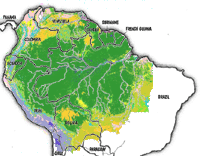The Amazon River
he Amazon Basin is the planets largest reservoir of fresh water. One fifth of all running water on the planet flows through the Amazon.
The Amazon River is 6,868 km (4000 miles) long, the same distance as North Cape (Honningsvåg - Norway) to Las Palmas (Canary Islands - Spain), a trip that will take you 4 days and 5 hours if you are traveling by car and don't stop to eat and sleep (Ship from Cadiz to Las Palmas). On the North-American continent it is the distance from Anchorage (Alaska - USA) to San Diego (California - USA) and then 200 miles into Mexico.
One hectare in the Amazon rainforest has been calculated to have a value of $6.820 (USD) if intact forest is sustainable harvested for fruits, latex, and timber; $1.000 (USD) if clear-cut for commercial timber (not sustainable harvested); or $148 (USD) if used as cattle pasture. In money, the Amazon rainforest should be worth USD 4.092.000.000.000 if sustainable harvested or only 2% of that number if used as cattle pasture.
For the global climate (and you) the Amazonian rainforest has a much bigger value. The Amazonian rainforest is estimated to accumulate 0.62 ±0.37 tonnes of carbon per hectare, per annum. Approximately, 300 million tons, but the logging and deforestation of the Amazon produces 200 million tons of CO2 every year, so a sustainable harvesting of the resources in the Amazon would really make a big difference for the global climate.
The images of fires raging out of control in the Eastern Amazon state of Pará are a powerful symbol of the way mankind continues to plunder and destroy nature. Of the Earth's original forests;
The total area of Amazon rainforest (over 6 million km2/ 2.3 million sq. miles) is bigger than Western Europe, covering an area equivalent to two thirds of the United States of America. The forest stretches to nine countries:
-
Bolivia
-
Brazil
-
Colombia
-
Ecuador
-
French Guyana
-
Guyana
-
Peru
-
Surinam
-
Venezuela.
During the rainy season from November to June, the main rivers in the Amazon rise (and) flood vast areas of the forest. The flooded area can spread out up to 200 kilometers from the river banks. In some rivers the difference in the water level between the wet and the dry season is equal to a building eight floors high.
During the floods river dolphins and fish are able to swim through the flooded forest. Fish are one of the most important pollinators of the forest eating fruits from the trees of the forest and dispersing their seeds.
The Startling Diversity of Life
-
The Amazon is one of the richest areas in the world in animal and plant diversity.
-
There are more plant species in one hectare in Amazon than the whole of Europe.
-
Over 200 species of trees can be found on one hectare in the Amazon region.
-
One tree has been shown to have 72 different species of ants living in it.
-
There are about 30 times more fish species in the Amazon river than in all European rivers.
The diversity and contrast of life in the Amazon rainforest
-
The Amazon Water Lily (Vitoria-Regia) is the biggest flower in the world with a diameter of two meters.
-
The caranguejeira spider is bigger than a baseball.
-
One species of monkey weighing 130 grams is about the size of a toothbrush.
| 
|
| Vitoria Regia - Amazon Water Lily |
Yet, the range of plant and animal species in Amazon remains largely unknown. Scientists estimate that only 40 % of all insect species have so far been identified. Over 30,000 species of plants have been identified so far but another 20, 000 are estimated to remain undiscovered. Only during the 1990's seven species of monkeys, two species of birds and dozens of species of frogs and fish have been discovered.
| 
|
| Caranguejeira - The Giant Spider |
The Amazon Rainforest is vital for rainfall in the region as water is continually recycled through the Amazon forest by evaporation and rain. Destruction of the forest has already led to changes in the micro climate with the possibility that further destruction will accelerate micro and regional climatic change.




